Unit 12 Organisational Behaviour Report: Morrison's Case Study
VerifiedAdded on 2023/01/03
|19
|5495
|75
Report
AI Summary
This report provides a comprehensive analysis of organisational behaviour, focusing on how organisational culture, politics, and power influence individual and team behaviour and performance, using Morrison's as a case study. The report explores various aspects, including the impact of culture (task, person, power, and role) on individuals and teams, the different types of power (legitimate, reward, expert) and their effects, and the influence of organisational politics. It delves into process and content theories of motivation, such as Adams' equity theory and Maslow's hierarchy, evaluating their application in influencing behaviour. The report further compares effective and ineffective teams, analysing team/group development theories to support dynamic cooperation. Finally, it applies concepts and philosophies of OB within an organisational context, evaluating their positive and negative influences on behaviour.
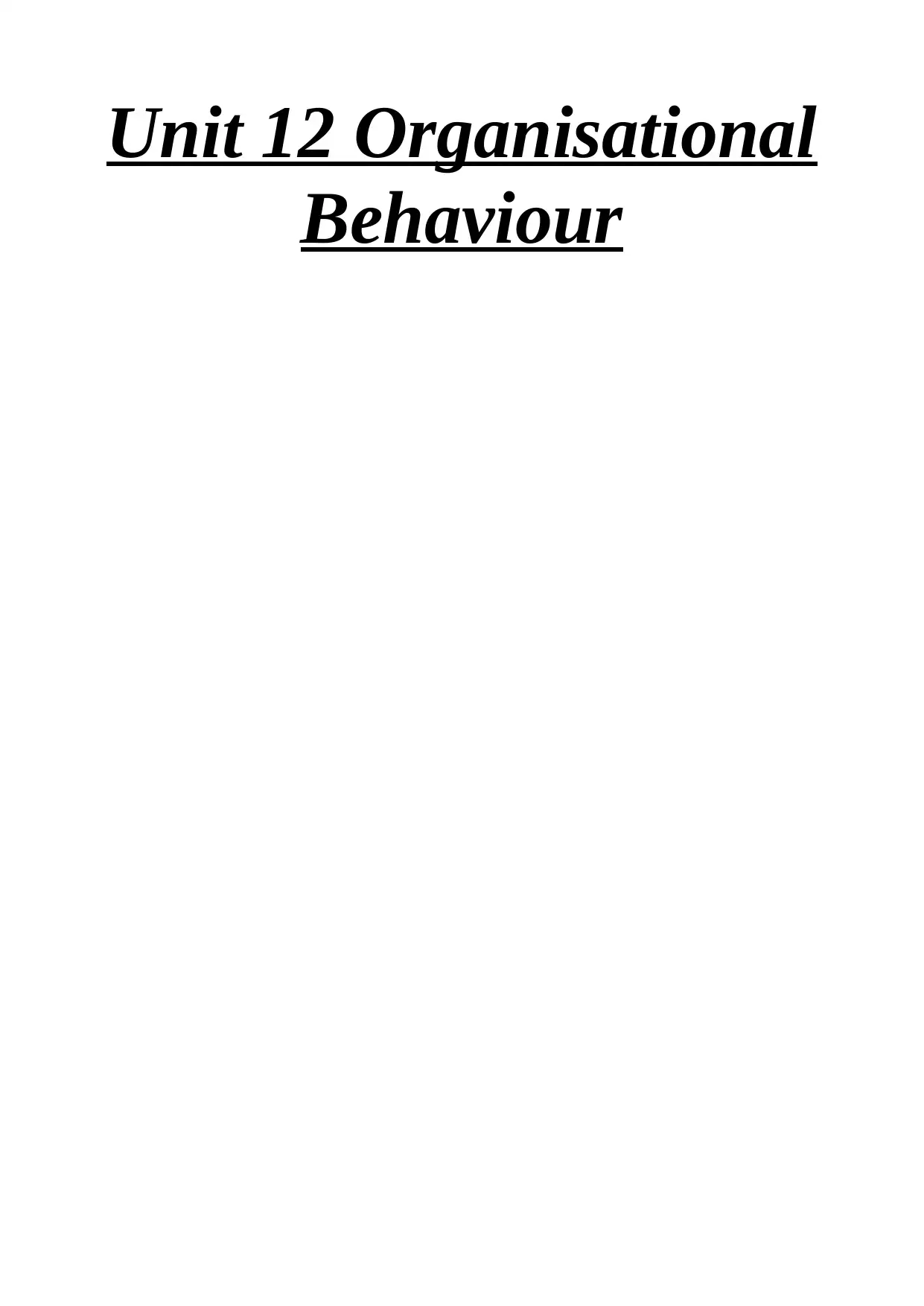
Unit 12 Organisational
Behaviour
Behaviour
Paraphrase This Document
Need a fresh take? Get an instant paraphrase of this document with our AI Paraphraser
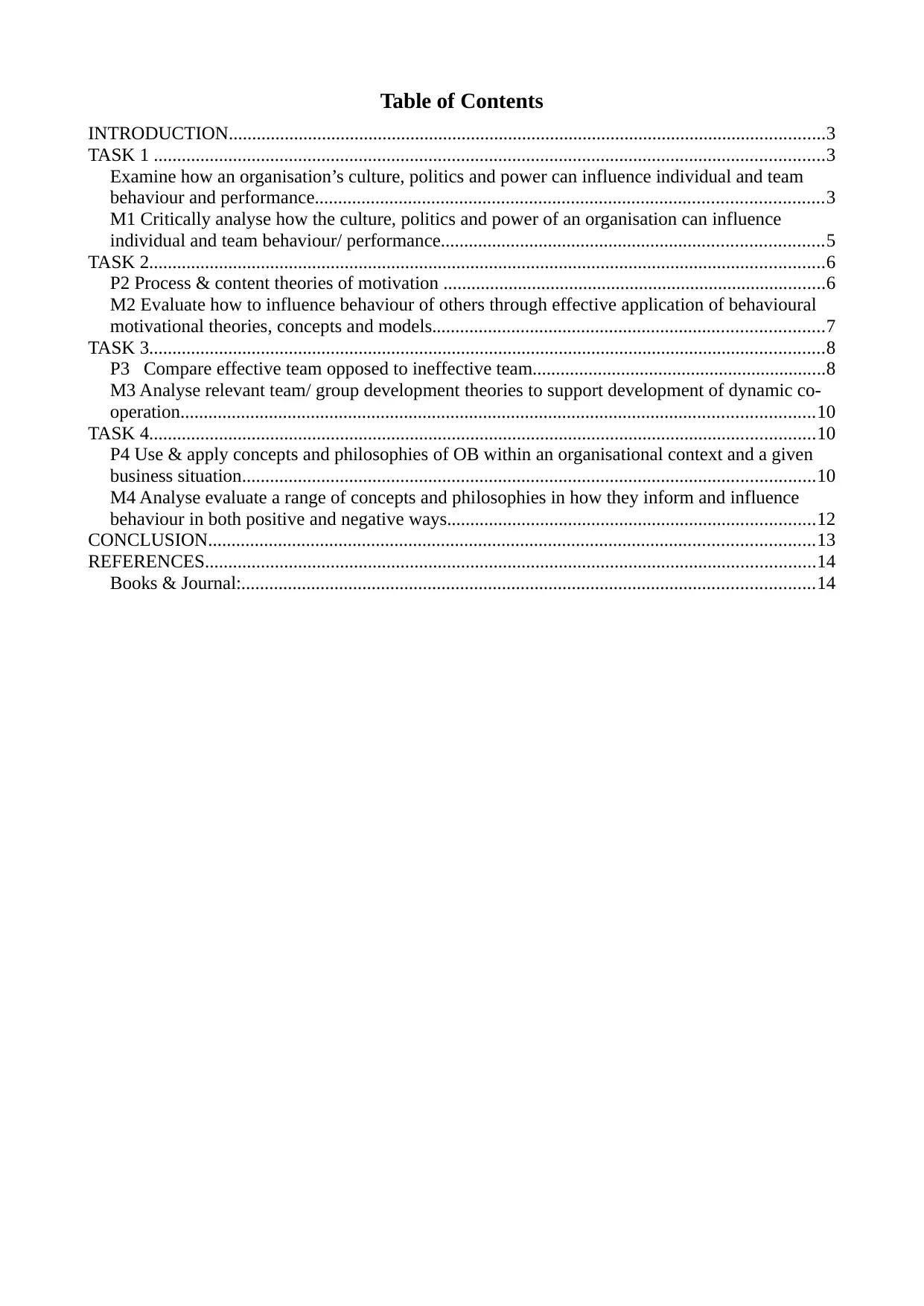
Table of Contents
INTRODUCTION................................................................................................................................3
TASK 1 ................................................................................................................................................3
Examine how an organisation’s culture, politics and power can influence individual and team
behaviour and performance.............................................................................................................3
M1 Critically analyse how the culture, politics and power of an organisation can influence
individual and team behaviour/ performance..................................................................................5
TASK 2.................................................................................................................................................6
P2 Process & content theories of motivation ..................................................................................6
M2 Evaluate how to influence behaviour of others through effective application of behavioural
motivational theories, concepts and models....................................................................................7
TASK 3.................................................................................................................................................8
P3 Compare effective team opposed to ineffective team...............................................................8
M3 Analyse relevant team/ group development theories to support development of dynamic co-
operation........................................................................................................................................10
TASK 4...............................................................................................................................................10
P4 Use & apply concepts and philosophies of OB within an organisational context and a given
business situation...........................................................................................................................10
M4 Analyse evaluate a range of concepts and philosophies in how they inform and influence
behaviour in both positive and negative ways...............................................................................12
CONCLUSION..................................................................................................................................13
REFERENCES...................................................................................................................................14
Books & Journal:...........................................................................................................................14
INTRODUCTION................................................................................................................................3
TASK 1 ................................................................................................................................................3
Examine how an organisation’s culture, politics and power can influence individual and team
behaviour and performance.............................................................................................................3
M1 Critically analyse how the culture, politics and power of an organisation can influence
individual and team behaviour/ performance..................................................................................5
TASK 2.................................................................................................................................................6
P2 Process & content theories of motivation ..................................................................................6
M2 Evaluate how to influence behaviour of others through effective application of behavioural
motivational theories, concepts and models....................................................................................7
TASK 3.................................................................................................................................................8
P3 Compare effective team opposed to ineffective team...............................................................8
M3 Analyse relevant team/ group development theories to support development of dynamic co-
operation........................................................................................................................................10
TASK 4...............................................................................................................................................10
P4 Use & apply concepts and philosophies of OB within an organisational context and a given
business situation...........................................................................................................................10
M4 Analyse evaluate a range of concepts and philosophies in how they inform and influence
behaviour in both positive and negative ways...............................................................................12
CONCLUSION..................................................................................................................................13
REFERENCES...................................................................................................................................14
Books & Journal:...........................................................................................................................14
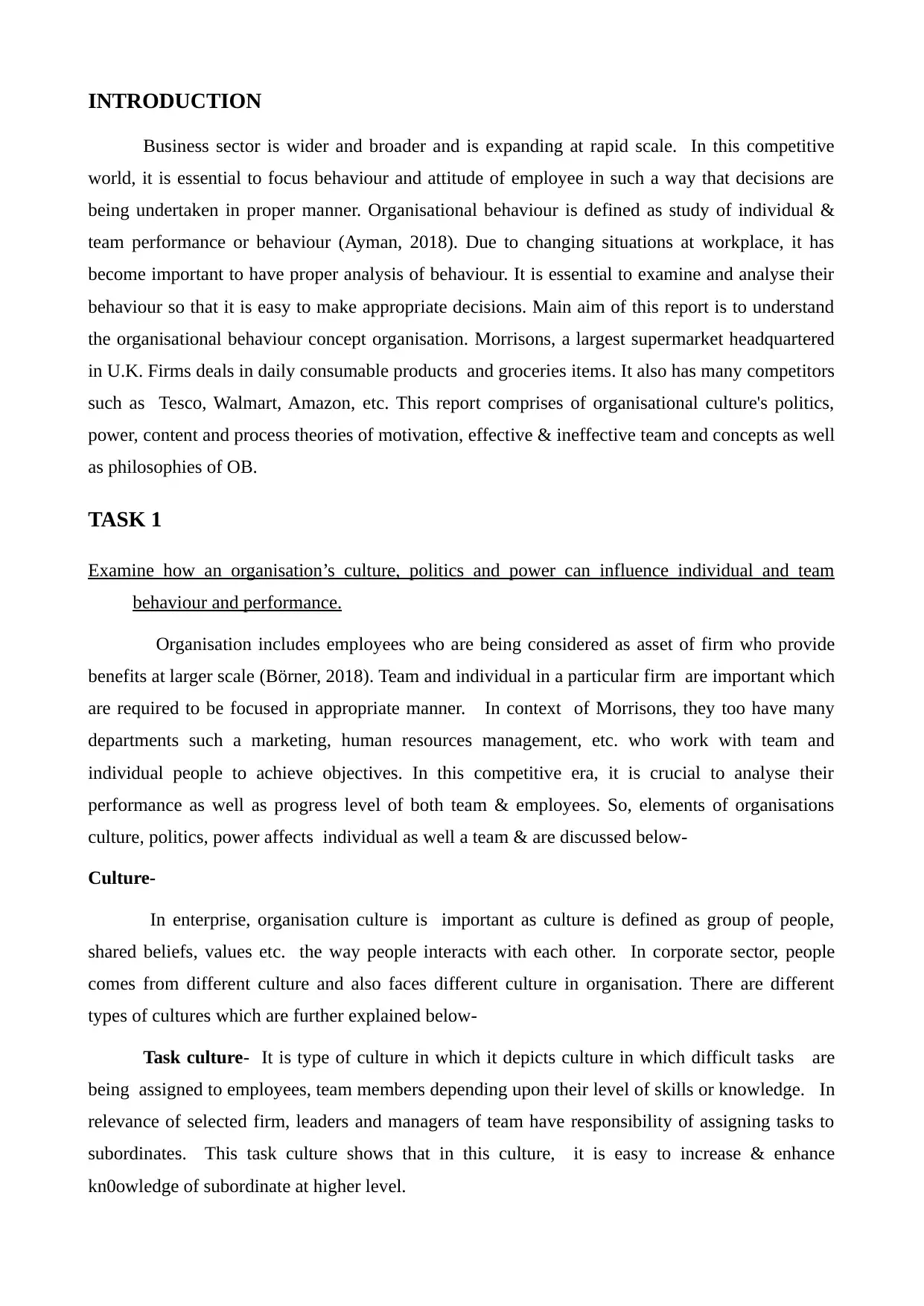
INTRODUCTION
Business sector is wider and broader and is expanding at rapid scale. In this competitive
world, it is essential to focus behaviour and attitude of employee in such a way that decisions are
being undertaken in proper manner. Organisational behaviour is defined as study of individual &
team performance or behaviour (Ayman, 2018). Due to changing situations at workplace, it has
become important to have proper analysis of behaviour. It is essential to examine and analyse their
behaviour so that it is easy to make appropriate decisions. Main aim of this report is to understand
the organisational behaviour concept organisation. Morrisons, a largest supermarket headquartered
in U.K. Firms deals in daily consumable products and groceries items. It also has many competitors
such as Tesco, Walmart, Amazon, etc. This report comprises of organisational culture's politics,
power, content and process theories of motivation, effective & ineffective team and concepts as well
as philosophies of OB.
TASK 1
Examine how an organisation’s culture, politics and power can influence individual and team
behaviour and performance.
Organisation includes employees who are being considered as asset of firm who provide
benefits at larger scale (Börner, 2018). Team and individual in a particular firm are important which
are required to be focused in appropriate manner. In context of Morrisons, they too have many
departments such a marketing, human resources management, etc. who work with team and
individual people to achieve objectives. In this competitive era, it is crucial to analyse their
performance as well as progress level of both team & employees. So, elements of organisations
culture, politics, power affects individual as well a team & are discussed below-
Culture-
In enterprise, organisation culture is important as culture is defined as group of people,
shared beliefs, values etc. the way people interacts with each other. In corporate sector, people
comes from different culture and also faces different culture in organisation. There are different
types of cultures which are further explained below-
Task culture- It is type of culture in which it depicts culture in which difficult tasks are
being assigned to employees, team members depending upon their level of skills or knowledge. In
relevance of selected firm, leaders and managers of team have responsibility of assigning tasks to
subordinates. This task culture shows that in this culture, it is easy to increase & enhance
kn0owledge of subordinate at higher level.
Business sector is wider and broader and is expanding at rapid scale. In this competitive
world, it is essential to focus behaviour and attitude of employee in such a way that decisions are
being undertaken in proper manner. Organisational behaviour is defined as study of individual &
team performance or behaviour (Ayman, 2018). Due to changing situations at workplace, it has
become important to have proper analysis of behaviour. It is essential to examine and analyse their
behaviour so that it is easy to make appropriate decisions. Main aim of this report is to understand
the organisational behaviour concept organisation. Morrisons, a largest supermarket headquartered
in U.K. Firms deals in daily consumable products and groceries items. It also has many competitors
such as Tesco, Walmart, Amazon, etc. This report comprises of organisational culture's politics,
power, content and process theories of motivation, effective & ineffective team and concepts as well
as philosophies of OB.
TASK 1
Examine how an organisation’s culture, politics and power can influence individual and team
behaviour and performance.
Organisation includes employees who are being considered as asset of firm who provide
benefits at larger scale (Börner, 2018). Team and individual in a particular firm are important which
are required to be focused in appropriate manner. In context of Morrisons, they too have many
departments such a marketing, human resources management, etc. who work with team and
individual people to achieve objectives. In this competitive era, it is crucial to analyse their
performance as well as progress level of both team & employees. So, elements of organisations
culture, politics, power affects individual as well a team & are discussed below-
Culture-
In enterprise, organisation culture is important as culture is defined as group of people,
shared beliefs, values etc. the way people interacts with each other. In corporate sector, people
comes from different culture and also faces different culture in organisation. There are different
types of cultures which are further explained below-
Task culture- It is type of culture in which it depicts culture in which difficult tasks are
being assigned to employees, team members depending upon their level of skills or knowledge. In
relevance of selected firm, leaders and managers of team have responsibility of assigning tasks to
subordinates. This task culture shows that in this culture, it is easy to increase & enhance
kn0owledge of subordinate at higher level.
⊘ This is a preview!⊘
Do you want full access?
Subscribe today to unlock all pages.

Trusted by 1+ million students worldwide
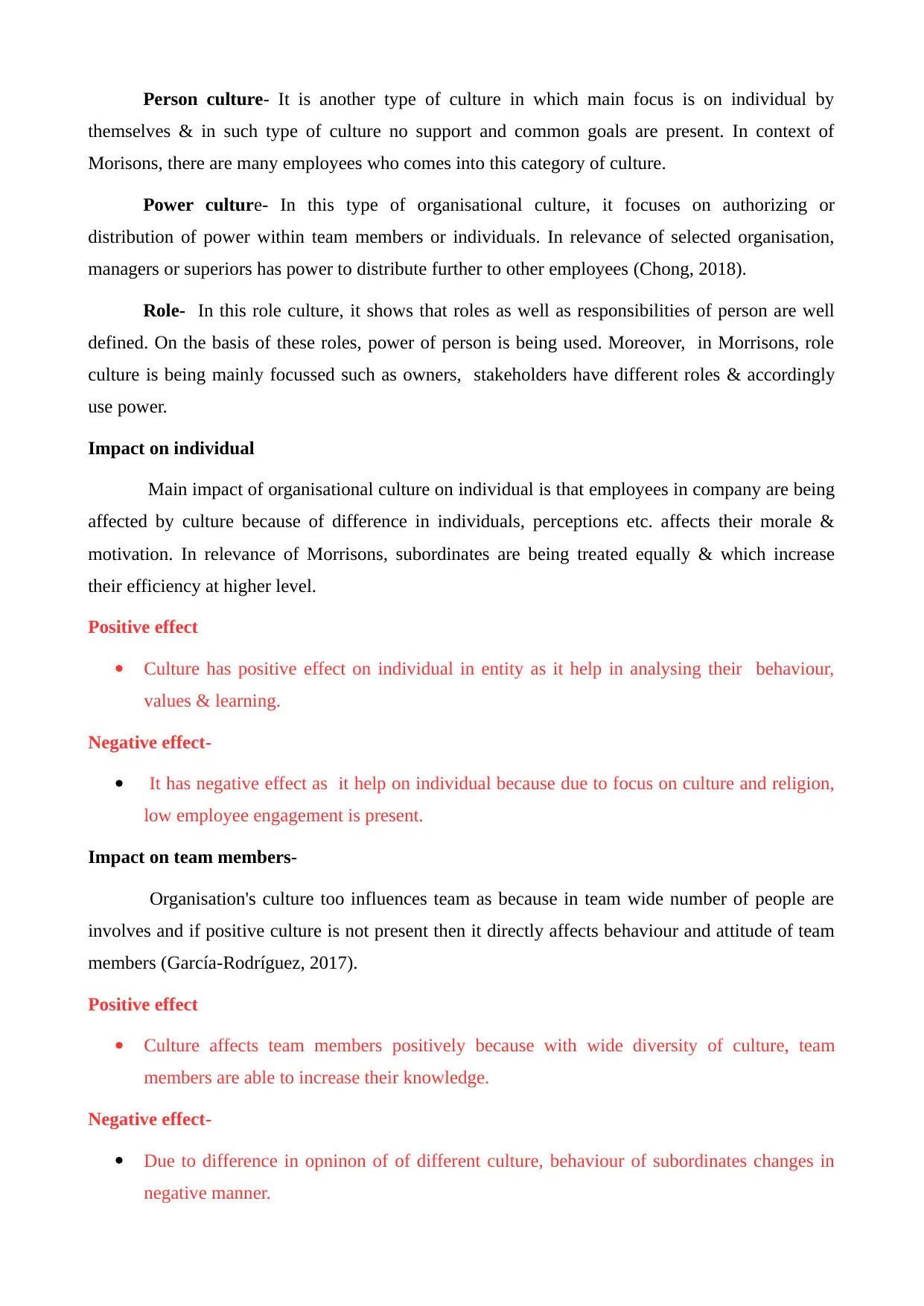
Person culture- It is another type of culture in which main focus is on individual by
themselves & in such type of culture no support and common goals are present. In context of
Morisons, there are many employees who comes into this category of culture.
Power culture- In this type of organisational culture, it focuses on authorizing or
distribution of power within team members or individuals. In relevance of selected organisation,
managers or superiors has power to distribute further to other employees (Chong, 2018).
Role- In this role culture, it shows that roles as well as responsibilities of person are well
defined. On the basis of these roles, power of person is being used. Moreover, in Morrisons, role
culture is being mainly focussed such as owners, stakeholders have different roles & accordingly
use power.
Impact on individual
Main impact of organisational culture on individual is that employees in company are being
affected by culture because of difference in individuals, perceptions etc. affects their morale &
motivation. In relevance of Morrisons, subordinates are being treated equally & which increase
their efficiency at higher level.
Positive effect
Culture has positive effect on individual in entity as it help in analysing their behaviour,
values & learning.
Negative effect-
It has negative effect as it help on individual because due to focus on culture and religion,
low employee engagement is present.
Impact on team members-
Organisation's culture too influences team as because in team wide number of people are
involves and if positive culture is not present then it directly affects behaviour and attitude of team
members (García-Rodríguez, 2017).
Positive effect
Culture affects team members positively because with wide diversity of culture, team
members are able to increase their knowledge.
Negative effect-
Due to difference in opninon of of different culture, behaviour of subordinates changes in
negative manner.
themselves & in such type of culture no support and common goals are present. In context of
Morisons, there are many employees who comes into this category of culture.
Power culture- In this type of organisational culture, it focuses on authorizing or
distribution of power within team members or individuals. In relevance of selected organisation,
managers or superiors has power to distribute further to other employees (Chong, 2018).
Role- In this role culture, it shows that roles as well as responsibilities of person are well
defined. On the basis of these roles, power of person is being used. Moreover, in Morrisons, role
culture is being mainly focussed such as owners, stakeholders have different roles & accordingly
use power.
Impact on individual
Main impact of organisational culture on individual is that employees in company are being
affected by culture because of difference in individuals, perceptions etc. affects their morale &
motivation. In relevance of Morrisons, subordinates are being treated equally & which increase
their efficiency at higher level.
Positive effect
Culture has positive effect on individual in entity as it help in analysing their behaviour,
values & learning.
Negative effect-
It has negative effect as it help on individual because due to focus on culture and religion,
low employee engagement is present.
Impact on team members-
Organisation's culture too influences team as because in team wide number of people are
involves and if positive culture is not present then it directly affects behaviour and attitude of team
members (García-Rodríguez, 2017).
Positive effect
Culture affects team members positively because with wide diversity of culture, team
members are able to increase their knowledge.
Negative effect-
Due to difference in opninon of of different culture, behaviour of subordinates changes in
negative manner.
Paraphrase This Document
Need a fresh take? Get an instant paraphrase of this document with our AI Paraphraser
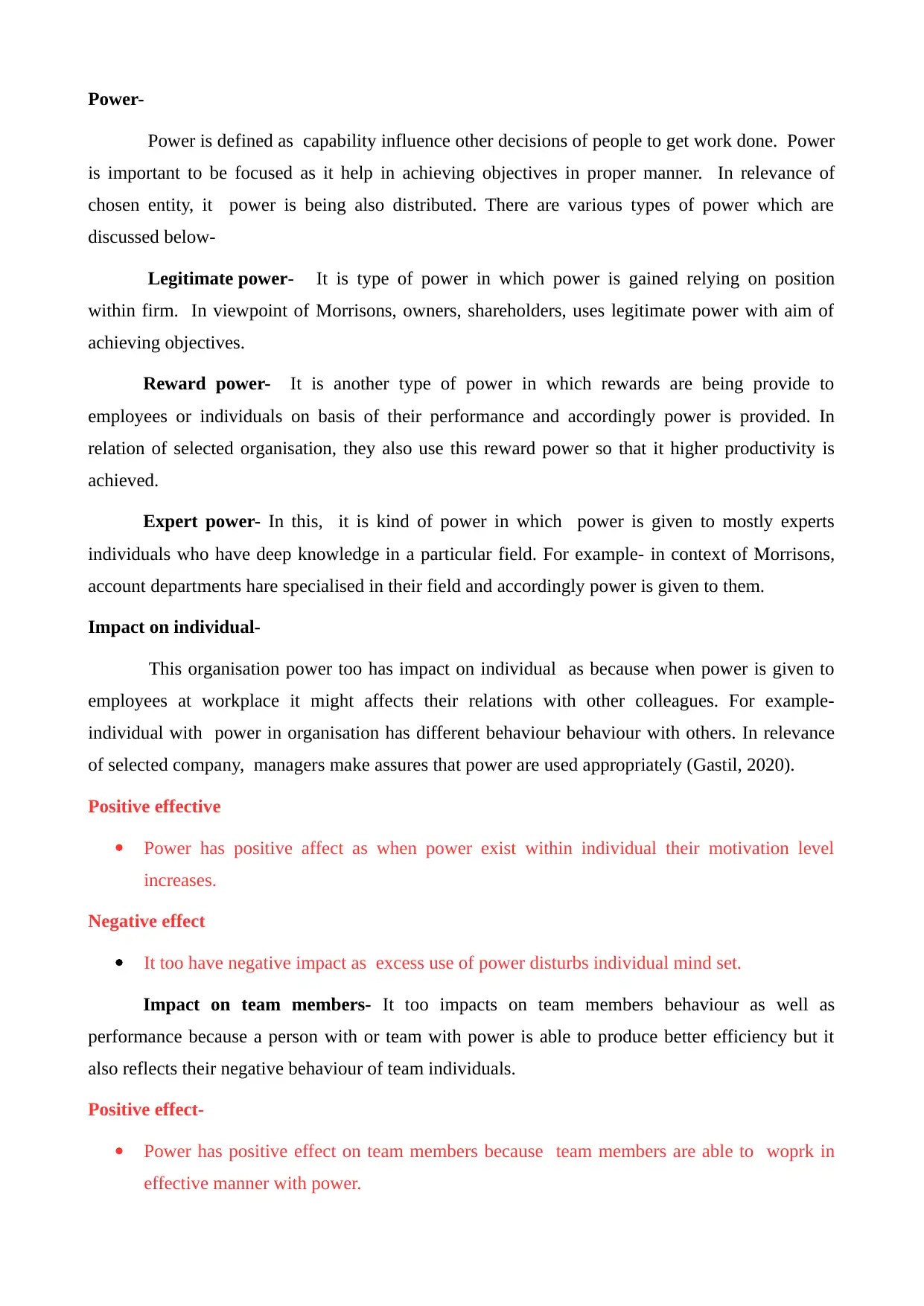
Power-
Power is defined as capability influence other decisions of people to get work done. Power
is important to be focused as it help in achieving objectives in proper manner. In relevance of
chosen entity, it power is being also distributed. There are various types of power which are
discussed below-
Legitimate power- It is type of power in which power is gained relying on position
within firm. In viewpoint of Morrisons, owners, shareholders, uses legitimate power with aim of
achieving objectives.
Reward power- It is another type of power in which rewards are being provide to
employees or individuals on basis of their performance and accordingly power is provided. In
relation of selected organisation, they also use this reward power so that it higher productivity is
achieved.
Expert power- In this, it is kind of power in which power is given to mostly experts
individuals who have deep knowledge in a particular field. For example- in context of Morrisons,
account departments hare specialised in their field and accordingly power is given to them.
Impact on individual-
This organisation power too has impact on individual as because when power is given to
employees at workplace it might affects their relations with other colleagues. For example-
individual with power in organisation has different behaviour behaviour with others. In relevance
of selected company, managers make assures that power are used appropriately (Gastil, 2020).
Positive effective
Power has positive affect as when power exist within individual their motivation level
increases.
Negative effect
It too have negative impact as excess use of power disturbs individual mind set.
Impact on team members- It too impacts on team members behaviour as well as
performance because a person with or team with power is able to produce better efficiency but it
also reflects their negative behaviour of team individuals.
Positive effect-
Power has positive effect on team members because team members are able to woprk in
effective manner with power.
Power is defined as capability influence other decisions of people to get work done. Power
is important to be focused as it help in achieving objectives in proper manner. In relevance of
chosen entity, it power is being also distributed. There are various types of power which are
discussed below-
Legitimate power- It is type of power in which power is gained relying on position
within firm. In viewpoint of Morrisons, owners, shareholders, uses legitimate power with aim of
achieving objectives.
Reward power- It is another type of power in which rewards are being provide to
employees or individuals on basis of their performance and accordingly power is provided. In
relation of selected organisation, they also use this reward power so that it higher productivity is
achieved.
Expert power- In this, it is kind of power in which power is given to mostly experts
individuals who have deep knowledge in a particular field. For example- in context of Morrisons,
account departments hare specialised in their field and accordingly power is given to them.
Impact on individual-
This organisation power too has impact on individual as because when power is given to
employees at workplace it might affects their relations with other colleagues. For example-
individual with power in organisation has different behaviour behaviour with others. In relevance
of selected company, managers make assures that power are used appropriately (Gastil, 2020).
Positive effective
Power has positive affect as when power exist within individual their motivation level
increases.
Negative effect
It too have negative impact as excess use of power disturbs individual mind set.
Impact on team members- It too impacts on team members behaviour as well as
performance because a person with or team with power is able to produce better efficiency but it
also reflects their negative behaviour of team individuals.
Positive effect-
Power has positive effect on team members because team members are able to woprk in
effective manner with power.
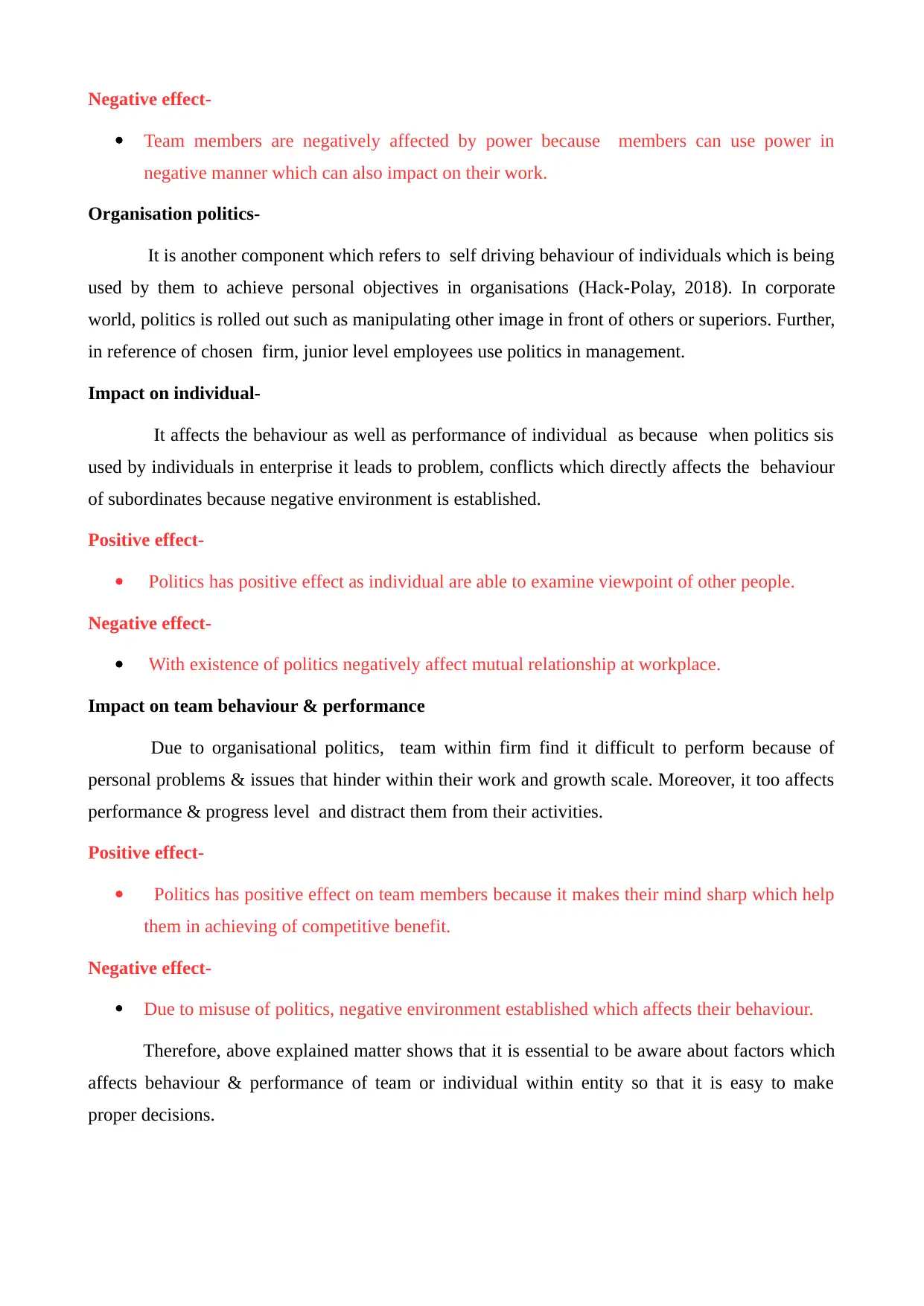
Negative effect-
Team members are negatively affected by power because members can use power in
negative manner which can also impact on their work.
Organisation politics-
It is another component which refers to self driving behaviour of individuals which is being
used by them to achieve personal objectives in organisations (Hack-Polay, 2018). In corporate
world, politics is rolled out such as manipulating other image in front of others or superiors. Further,
in reference of chosen firm, junior level employees use politics in management.
Impact on individual-
It affects the behaviour as well as performance of individual as because when politics sis
used by individuals in enterprise it leads to problem, conflicts which directly affects the behaviour
of subordinates because negative environment is established.
Positive effect-
Politics has positive effect as individual are able to examine viewpoint of other people.
Negative effect-
With existence of politics negatively affect mutual relationship at workplace.
Impact on team behaviour & performance
Due to organisational politics, team within firm find it difficult to perform because of
personal problems & issues that hinder within their work and growth scale. Moreover, it too affects
performance & progress level and distract them from their activities.
Positive effect-
Politics has positive effect on team members because it makes their mind sharp which help
them in achieving of competitive benefit.
Negative effect-
Due to misuse of politics, negative environment established which affects their behaviour.
Therefore, above explained matter shows that it is essential to be aware about factors which
affects behaviour & performance of team or individual within entity so that it is easy to make
proper decisions.
Team members are negatively affected by power because members can use power in
negative manner which can also impact on their work.
Organisation politics-
It is another component which refers to self driving behaviour of individuals which is being
used by them to achieve personal objectives in organisations (Hack-Polay, 2018). In corporate
world, politics is rolled out such as manipulating other image in front of others or superiors. Further,
in reference of chosen firm, junior level employees use politics in management.
Impact on individual-
It affects the behaviour as well as performance of individual as because when politics sis
used by individuals in enterprise it leads to problem, conflicts which directly affects the behaviour
of subordinates because negative environment is established.
Positive effect-
Politics has positive effect as individual are able to examine viewpoint of other people.
Negative effect-
With existence of politics negatively affect mutual relationship at workplace.
Impact on team behaviour & performance
Due to organisational politics, team within firm find it difficult to perform because of
personal problems & issues that hinder within their work and growth scale. Moreover, it too affects
performance & progress level and distract them from their activities.
Positive effect-
Politics has positive effect on team members because it makes their mind sharp which help
them in achieving of competitive benefit.
Negative effect-
Due to misuse of politics, negative environment established which affects their behaviour.
Therefore, above explained matter shows that it is essential to be aware about factors which
affects behaviour & performance of team or individual within entity so that it is easy to make
proper decisions.
⊘ This is a preview!⊘
Do you want full access?
Subscribe today to unlock all pages.

Trusted by 1+ million students worldwide
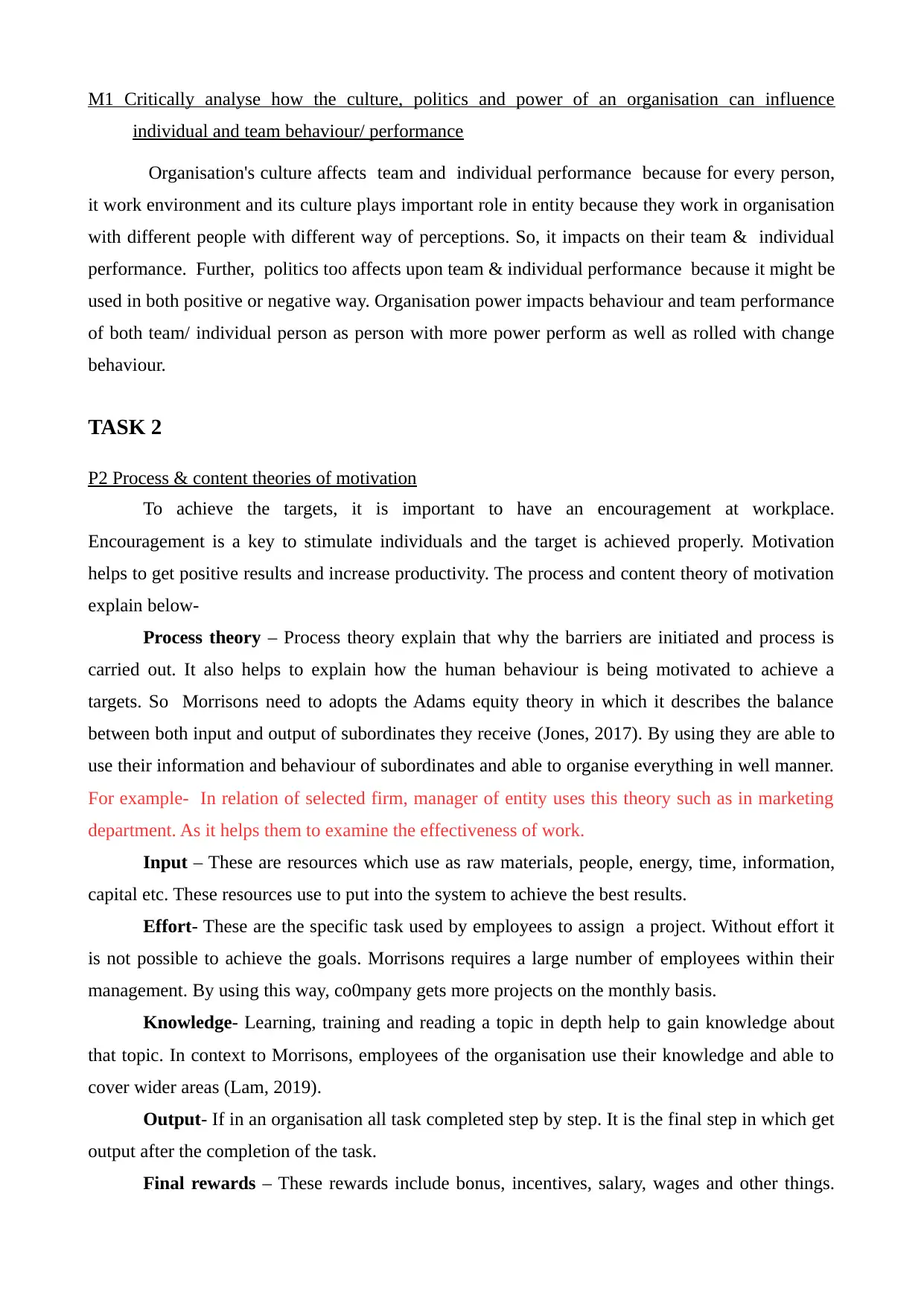
M1 Critically analyse how the culture, politics and power of an organisation can influence
individual and team behaviour/ performance
Organisation's culture affects team and individual performance because for every person,
it work environment and its culture plays important role in entity because they work in organisation
with different people with different way of perceptions. So, it impacts on their team & individual
performance. Further, politics too affects upon team & individual performance because it might be
used in both positive or negative way. Organisation power impacts behaviour and team performance
of both team/ individual person as person with more power perform as well as rolled with change
behaviour.
TASK 2
P2 Process & content theories of motivation
To achieve the targets, it is important to have an encouragement at workplace.
Encouragement is a key to stimulate individuals and the target is achieved properly. Motivation
helps to get positive results and increase productivity. The process and content theory of motivation
explain below-
Process theory – Process theory explain that why the barriers are initiated and process is
carried out. It also helps to explain how the human behaviour is being motivated to achieve a
targets. So Morrisons need to adopts the Adams equity theory in which it describes the balance
between both input and output of subordinates they receive (Jones, 2017). By using they are able to
use their information and behaviour of subordinates and able to organise everything in well manner.
For example- In relation of selected firm, manager of entity uses this theory such as in marketing
department. As it helps them to examine the effectiveness of work.
Input – These are resources which use as raw materials, people, energy, time, information,
capital etc. These resources use to put into the system to achieve the best results.
Effort- These are the specific task used by employees to assign a project. Without effort it
is not possible to achieve the goals. Morrisons requires a large number of employees within their
management. By using this way, co0mpany gets more projects on the monthly basis.
Knowledge- Learning, training and reading a topic in depth help to gain knowledge about
that topic. In context to Morrisons, employees of the organisation use their knowledge and able to
cover wider areas (Lam, 2019).
Output- If in an organisation all task completed step by step. It is the final step in which get
output after the completion of the task.
Final rewards – These rewards include bonus, incentives, salary, wages and other things.
individual and team behaviour/ performance
Organisation's culture affects team and individual performance because for every person,
it work environment and its culture plays important role in entity because they work in organisation
with different people with different way of perceptions. So, it impacts on their team & individual
performance. Further, politics too affects upon team & individual performance because it might be
used in both positive or negative way. Organisation power impacts behaviour and team performance
of both team/ individual person as person with more power perform as well as rolled with change
behaviour.
TASK 2
P2 Process & content theories of motivation
To achieve the targets, it is important to have an encouragement at workplace.
Encouragement is a key to stimulate individuals and the target is achieved properly. Motivation
helps to get positive results and increase productivity. The process and content theory of motivation
explain below-
Process theory – Process theory explain that why the barriers are initiated and process is
carried out. It also helps to explain how the human behaviour is being motivated to achieve a
targets. So Morrisons need to adopts the Adams equity theory in which it describes the balance
between both input and output of subordinates they receive (Jones, 2017). By using they are able to
use their information and behaviour of subordinates and able to organise everything in well manner.
For example- In relation of selected firm, manager of entity uses this theory such as in marketing
department. As it helps them to examine the effectiveness of work.
Input – These are resources which use as raw materials, people, energy, time, information,
capital etc. These resources use to put into the system to achieve the best results.
Effort- These are the specific task used by employees to assign a project. Without effort it
is not possible to achieve the goals. Morrisons requires a large number of employees within their
management. By using this way, co0mpany gets more projects on the monthly basis.
Knowledge- Learning, training and reading a topic in depth help to gain knowledge about
that topic. In context to Morrisons, employees of the organisation use their knowledge and able to
cover wider areas (Lam, 2019).
Output- If in an organisation all task completed step by step. It is the final step in which get
output after the completion of the task.
Final rewards – These rewards include bonus, incentives, salary, wages and other things.
Paraphrase This Document
Need a fresh take? Get an instant paraphrase of this document with our AI Paraphraser
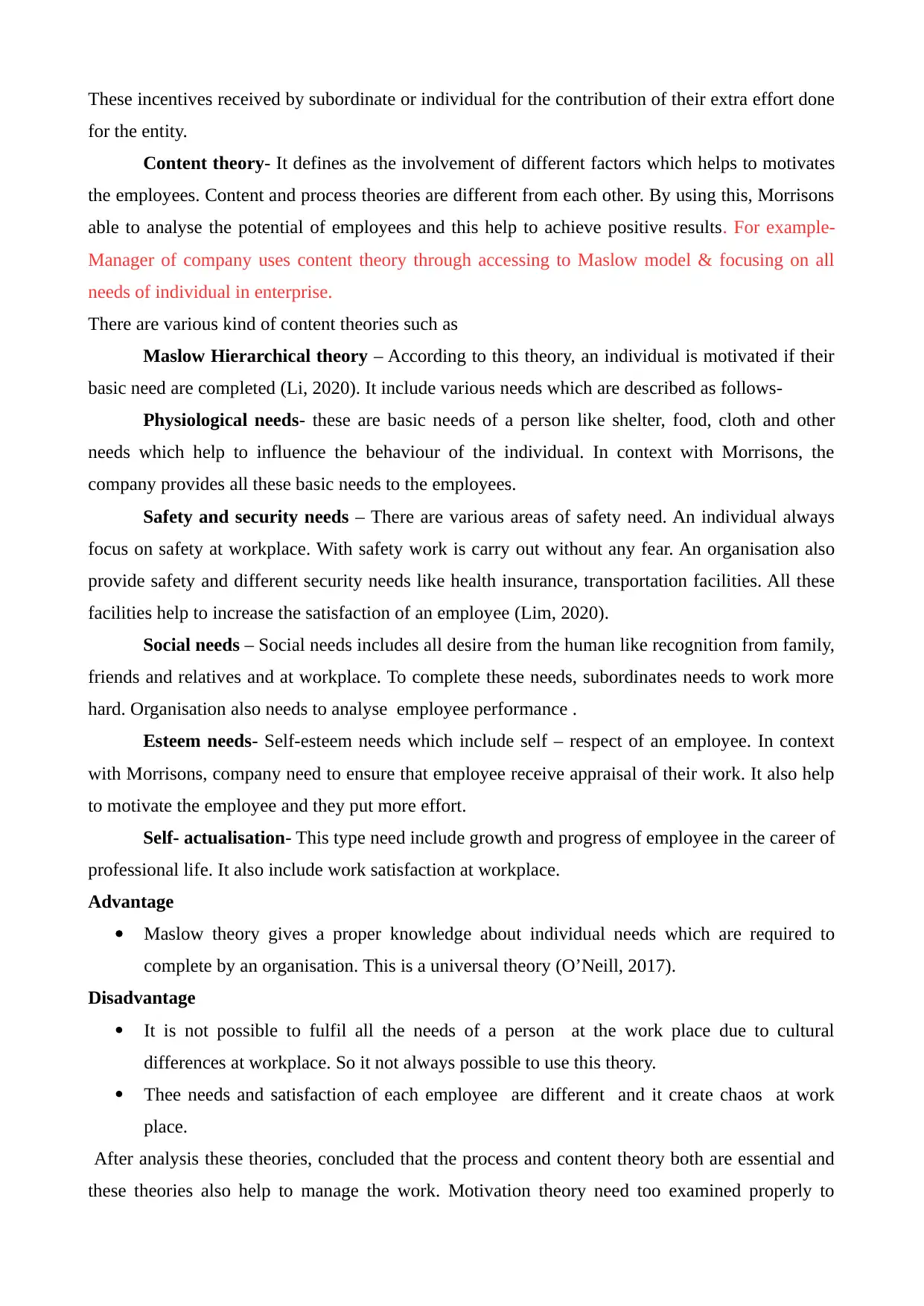
These incentives received by subordinate or individual for the contribution of their extra effort done
for the entity.
Content theory- It defines as the involvement of different factors which helps to motivates
the employees. Content and process theories are different from each other. By using this, Morrisons
able to analyse the potential of employees and this help to achieve positive results. For example-
Manager of company uses content theory through accessing to Maslow model & focusing on all
needs of individual in enterprise.
There are various kind of content theories such as
Maslow Hierarchical theory – According to this theory, an individual is motivated if their
basic need are completed (Li, 2020). It include various needs which are described as follows-
Physiological needs- these are basic needs of a person like shelter, food, cloth and other
needs which help to influence the behaviour of the individual. In context with Morrisons, the
company provides all these basic needs to the employees.
Safety and security needs – There are various areas of safety need. An individual always
focus on safety at workplace. With safety work is carry out without any fear. An organisation also
provide safety and different security needs like health insurance, transportation facilities. All these
facilities help to increase the satisfaction of an employee (Lim, 2020).
Social needs – Social needs includes all desire from the human like recognition from family,
friends and relatives and at workplace. To complete these needs, subordinates needs to work more
hard. Organisation also needs to analyse employee performance .
Esteem needs- Self-esteem needs which include self – respect of an employee. In context
with Morrisons, company need to ensure that employee receive appraisal of their work. It also help
to motivate the employee and they put more effort.
Self- actualisation- This type need include growth and progress of employee in the career of
professional life. It also include work satisfaction at workplace.
Advantage
Maslow theory gives a proper knowledge about individual needs which are required to
complete by an organisation. This is a universal theory (O’Neill, 2017).
Disadvantage
It is not possible to fulfil all the needs of a person at the work place due to cultural
differences at workplace. So it not always possible to use this theory.
Thee needs and satisfaction of each employee are different and it create chaos at work
place.
After analysis these theories, concluded that the process and content theory both are essential and
these theories also help to manage the work. Motivation theory need too examined properly to
for the entity.
Content theory- It defines as the involvement of different factors which helps to motivates
the employees. Content and process theories are different from each other. By using this, Morrisons
able to analyse the potential of employees and this help to achieve positive results. For example-
Manager of company uses content theory through accessing to Maslow model & focusing on all
needs of individual in enterprise.
There are various kind of content theories such as
Maslow Hierarchical theory – According to this theory, an individual is motivated if their
basic need are completed (Li, 2020). It include various needs which are described as follows-
Physiological needs- these are basic needs of a person like shelter, food, cloth and other
needs which help to influence the behaviour of the individual. In context with Morrisons, the
company provides all these basic needs to the employees.
Safety and security needs – There are various areas of safety need. An individual always
focus on safety at workplace. With safety work is carry out without any fear. An organisation also
provide safety and different security needs like health insurance, transportation facilities. All these
facilities help to increase the satisfaction of an employee (Lim, 2020).
Social needs – Social needs includes all desire from the human like recognition from family,
friends and relatives and at workplace. To complete these needs, subordinates needs to work more
hard. Organisation also needs to analyse employee performance .
Esteem needs- Self-esteem needs which include self – respect of an employee. In context
with Morrisons, company need to ensure that employee receive appraisal of their work. It also help
to motivate the employee and they put more effort.
Self- actualisation- This type need include growth and progress of employee in the career of
professional life. It also include work satisfaction at workplace.
Advantage
Maslow theory gives a proper knowledge about individual needs which are required to
complete by an organisation. This is a universal theory (O’Neill, 2017).
Disadvantage
It is not possible to fulfil all the needs of a person at the work place due to cultural
differences at workplace. So it not always possible to use this theory.
Thee needs and satisfaction of each employee are different and it create chaos at work
place.
After analysis these theories, concluded that the process and content theory both are essential and
these theories also help to manage the work. Motivation theory need too examined properly to
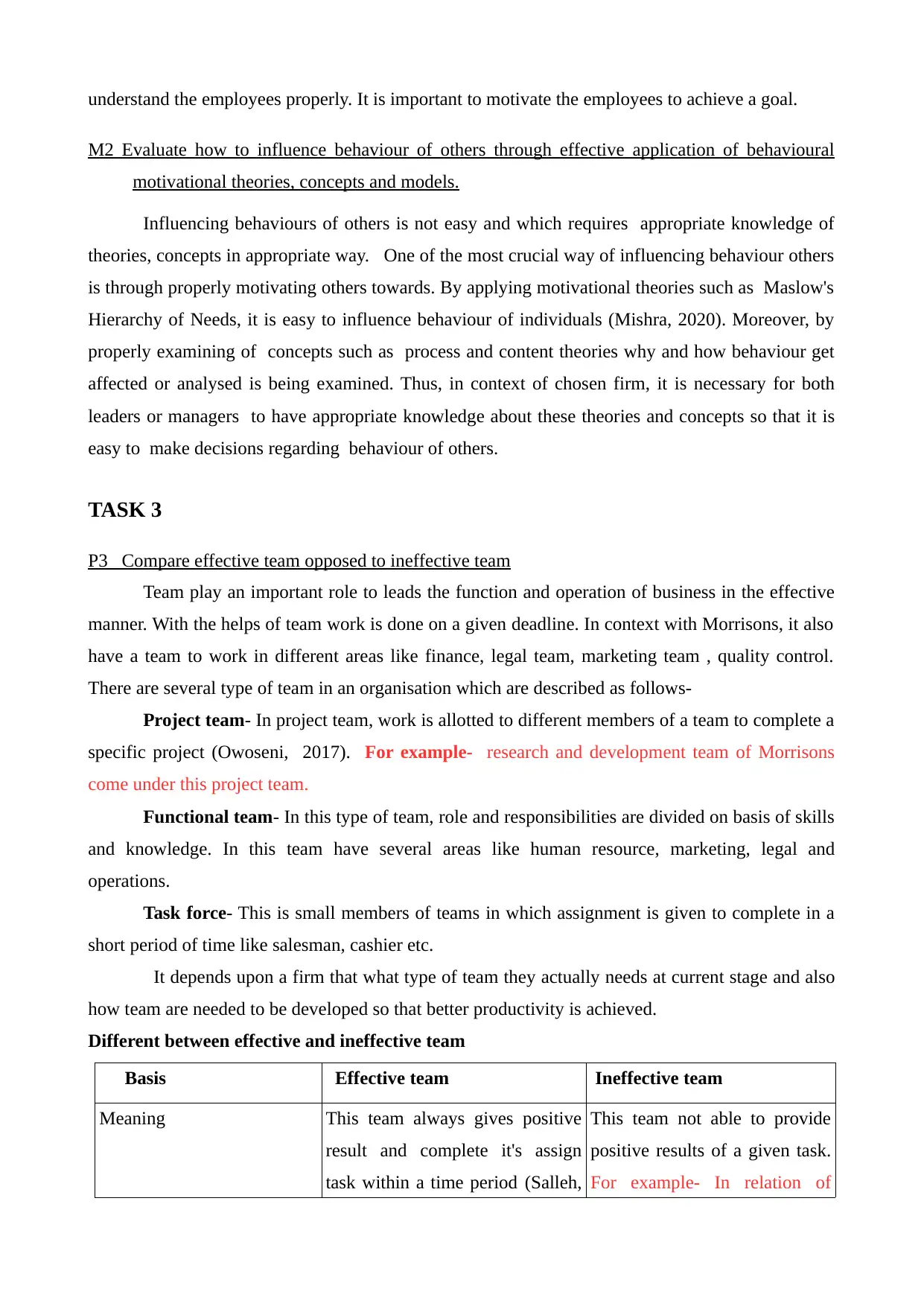
understand the employees properly. It is important to motivate the employees to achieve a goal.
M2 Evaluate how to influence behaviour of others through effective application of behavioural
motivational theories, concepts and models.
Influencing behaviours of others is not easy and which requires appropriate knowledge of
theories, concepts in appropriate way. One of the most crucial way of influencing behaviour others
is through properly motivating others towards. By applying motivational theories such as Maslow's
Hierarchy of Needs, it is easy to influence behaviour of individuals (Mishra, 2020). Moreover, by
properly examining of concepts such as process and content theories why and how behaviour get
affected or analysed is being examined. Thus, in context of chosen firm, it is necessary for both
leaders or managers to have appropriate knowledge about these theories and concepts so that it is
easy to make decisions regarding behaviour of others.
TASK 3
P3 Compare effective team opposed to ineffective team
Team play an important role to leads the function and operation of business in the effective
manner. With the helps of team work is done on a given deadline. In context with Morrisons, it also
have a team to work in different areas like finance, legal team, marketing team , quality control.
There are several type of team in an organisation which are described as follows-
Project team- In project team, work is allotted to different members of a team to complete a
specific project (Owoseni, 2017). For example- research and development team of Morrisons
come under this project team.
Functional team- In this type of team, role and responsibilities are divided on basis of skills
and knowledge. In this team have several areas like human resource, marketing, legal and
operations.
Task force- This is small members of teams in which assignment is given to complete in a
short period of time like salesman, cashier etc.
It depends upon a firm that what type of team they actually needs at current stage and also
how team are needed to be developed so that better productivity is achieved.
Different between effective and ineffective team
Basis Effective team Ineffective team
Meaning This team always gives positive
result and complete it's assign
task within a time period (Salleh,
This team not able to provide
positive results of a given task.
For example- In relation of
M2 Evaluate how to influence behaviour of others through effective application of behavioural
motivational theories, concepts and models.
Influencing behaviours of others is not easy and which requires appropriate knowledge of
theories, concepts in appropriate way. One of the most crucial way of influencing behaviour others
is through properly motivating others towards. By applying motivational theories such as Maslow's
Hierarchy of Needs, it is easy to influence behaviour of individuals (Mishra, 2020). Moreover, by
properly examining of concepts such as process and content theories why and how behaviour get
affected or analysed is being examined. Thus, in context of chosen firm, it is necessary for both
leaders or managers to have appropriate knowledge about these theories and concepts so that it is
easy to make decisions regarding behaviour of others.
TASK 3
P3 Compare effective team opposed to ineffective team
Team play an important role to leads the function and operation of business in the effective
manner. With the helps of team work is done on a given deadline. In context with Morrisons, it also
have a team to work in different areas like finance, legal team, marketing team , quality control.
There are several type of team in an organisation which are described as follows-
Project team- In project team, work is allotted to different members of a team to complete a
specific project (Owoseni, 2017). For example- research and development team of Morrisons
come under this project team.
Functional team- In this type of team, role and responsibilities are divided on basis of skills
and knowledge. In this team have several areas like human resource, marketing, legal and
operations.
Task force- This is small members of teams in which assignment is given to complete in a
short period of time like salesman, cashier etc.
It depends upon a firm that what type of team they actually needs at current stage and also
how team are needed to be developed so that better productivity is achieved.
Different between effective and ineffective team
Basis Effective team Ineffective team
Meaning This team always gives positive
result and complete it's assign
task within a time period (Salleh,
This team not able to provide
positive results of a given task.
For example- In relation of
⊘ This is a preview!⊘
Do you want full access?
Subscribe today to unlock all pages.

Trusted by 1+ million students worldwide
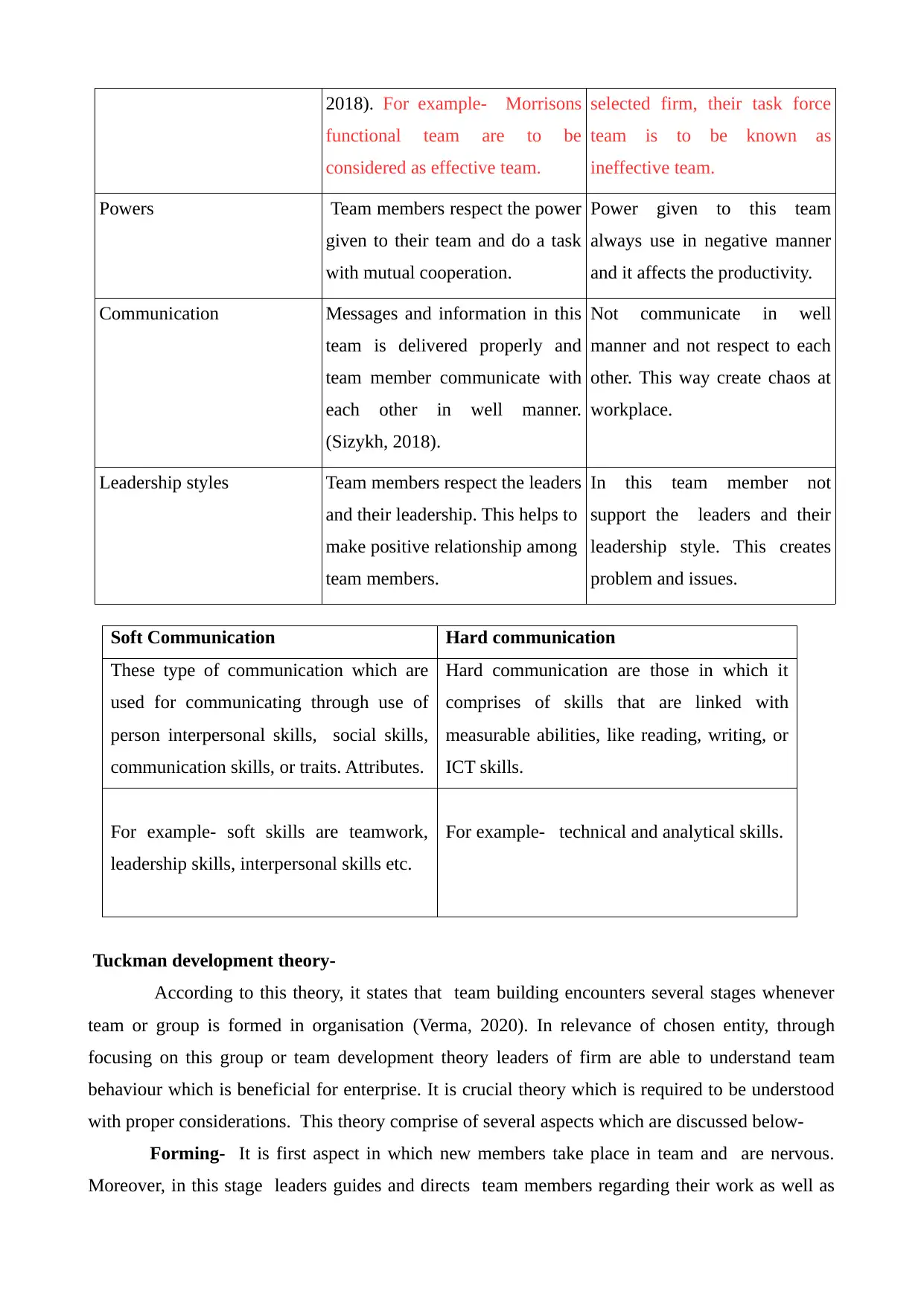
2018). For example- Morrisons
functional team are to be
considered as effective team.
selected firm, their task force
team is to be known as
ineffective team.
Powers Team members respect the power
given to their team and do a task
with mutual cooperation.
Power given to this team
always use in negative manner
and it affects the productivity.
Communication Messages and information in this
team is delivered properly and
team member communicate with
each other in well manner.
(Sizykh, 2018).
Not communicate in well
manner and not respect to each
other. This way create chaos at
workplace.
Leadership styles Team members respect the leaders
and their leadership. This helps to
make positive relationship among
team members.
In this team member not
support the leaders and their
leadership style. This creates
problem and issues.
Soft Communication Hard communication
These type of communication which are
used for communicating through use of
person interpersonal skills, social skills,
communication skills, or traits. Attributes.
Hard communication are those in which it
comprises of skills that are linked with
measurable abilities, like reading, writing, or
ICT skills.
For example- soft skills are teamwork,
leadership skills, interpersonal skills etc.
For example- technical and analytical skills.
Tuckman development theory-
According to this theory, it states that team building encounters several stages whenever
team or group is formed in organisation (Verma, 2020). In relevance of chosen entity, through
focusing on this group or team development theory leaders of firm are able to understand team
behaviour which is beneficial for enterprise. It is crucial theory which is required to be understood
with proper considerations. This theory comprise of several aspects which are discussed below-
Forming- It is first aspect in which new members take place in team and are nervous.
Moreover, in this stage leaders guides and directs team members regarding their work as well as
functional team are to be
considered as effective team.
selected firm, their task force
team is to be known as
ineffective team.
Powers Team members respect the power
given to their team and do a task
with mutual cooperation.
Power given to this team
always use in negative manner
and it affects the productivity.
Communication Messages and information in this
team is delivered properly and
team member communicate with
each other in well manner.
(Sizykh, 2018).
Not communicate in well
manner and not respect to each
other. This way create chaos at
workplace.
Leadership styles Team members respect the leaders
and their leadership. This helps to
make positive relationship among
team members.
In this team member not
support the leaders and their
leadership style. This creates
problem and issues.
Soft Communication Hard communication
These type of communication which are
used for communicating through use of
person interpersonal skills, social skills,
communication skills, or traits. Attributes.
Hard communication are those in which it
comprises of skills that are linked with
measurable abilities, like reading, writing, or
ICT skills.
For example- soft skills are teamwork,
leadership skills, interpersonal skills etc.
For example- technical and analytical skills.
Tuckman development theory-
According to this theory, it states that team building encounters several stages whenever
team or group is formed in organisation (Verma, 2020). In relevance of chosen entity, through
focusing on this group or team development theory leaders of firm are able to understand team
behaviour which is beneficial for enterprise. It is crucial theory which is required to be understood
with proper considerations. This theory comprise of several aspects which are discussed below-
Forming- It is first aspect in which new members take place in team and are nervous.
Moreover, in this stage leaders guides and directs team members regarding their work as well as
Paraphrase This Document
Need a fresh take? Get an instant paraphrase of this document with our AI Paraphraser
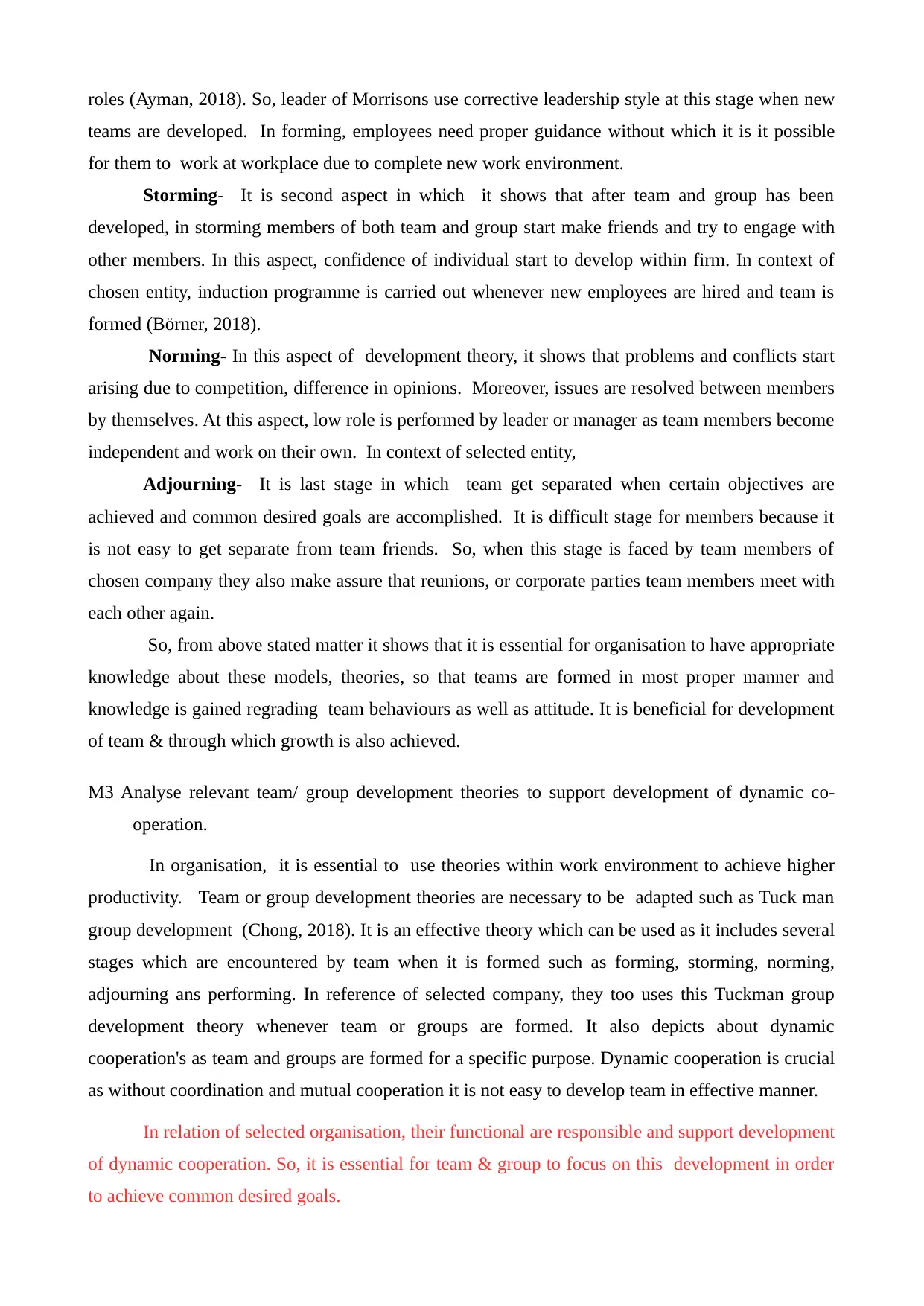
roles (Ayman, 2018). So, leader of Morrisons use corrective leadership style at this stage when new
teams are developed. In forming, employees need proper guidance without which it is it possible
for them to work at workplace due to complete new work environment.
Storming- It is second aspect in which it shows that after team and group has been
developed, in storming members of both team and group start make friends and try to engage with
other members. In this aspect, confidence of individual start to develop within firm. In context of
chosen entity, induction programme is carried out whenever new employees are hired and team is
formed (Börner, 2018).
Norming- In this aspect of development theory, it shows that problems and conflicts start
arising due to competition, difference in opinions. Moreover, issues are resolved between members
by themselves. At this aspect, low role is performed by leader or manager as team members become
independent and work on their own. In context of selected entity,
Adjourning- It is last stage in which team get separated when certain objectives are
achieved and common desired goals are accomplished. It is difficult stage for members because it
is not easy to get separate from team friends. So, when this stage is faced by team members of
chosen company they also make assure that reunions, or corporate parties team members meet with
each other again.
So, from above stated matter it shows that it is essential for organisation to have appropriate
knowledge about these models, theories, so that teams are formed in most proper manner and
knowledge is gained regrading team behaviours as well as attitude. It is beneficial for development
of team & through which growth is also achieved.
M3 Analyse relevant team/ group development theories to support development of dynamic co-
operation.
In organisation, it is essential to use theories within work environment to achieve higher
productivity. Team or group development theories are necessary to be adapted such as Tuck man
group development (Chong, 2018). It is an effective theory which can be used as it includes several
stages which are encountered by team when it is formed such as forming, storming, norming,
adjourning ans performing. In reference of selected company, they too uses this Tuckman group
development theory whenever team or groups are formed. It also depicts about dynamic
cooperation's as team and groups are formed for a specific purpose. Dynamic cooperation is crucial
as without coordination and mutual cooperation it is not easy to develop team in effective manner.
In relation of selected organisation, their functional are responsible and support development
of dynamic cooperation. So, it is essential for team & group to focus on this development in order
to achieve common desired goals.
teams are developed. In forming, employees need proper guidance without which it is it possible
for them to work at workplace due to complete new work environment.
Storming- It is second aspect in which it shows that after team and group has been
developed, in storming members of both team and group start make friends and try to engage with
other members. In this aspect, confidence of individual start to develop within firm. In context of
chosen entity, induction programme is carried out whenever new employees are hired and team is
formed (Börner, 2018).
Norming- In this aspect of development theory, it shows that problems and conflicts start
arising due to competition, difference in opinions. Moreover, issues are resolved between members
by themselves. At this aspect, low role is performed by leader or manager as team members become
independent and work on their own. In context of selected entity,
Adjourning- It is last stage in which team get separated when certain objectives are
achieved and common desired goals are accomplished. It is difficult stage for members because it
is not easy to get separate from team friends. So, when this stage is faced by team members of
chosen company they also make assure that reunions, or corporate parties team members meet with
each other again.
So, from above stated matter it shows that it is essential for organisation to have appropriate
knowledge about these models, theories, so that teams are formed in most proper manner and
knowledge is gained regrading team behaviours as well as attitude. It is beneficial for development
of team & through which growth is also achieved.
M3 Analyse relevant team/ group development theories to support development of dynamic co-
operation.
In organisation, it is essential to use theories within work environment to achieve higher
productivity. Team or group development theories are necessary to be adapted such as Tuck man
group development (Chong, 2018). It is an effective theory which can be used as it includes several
stages which are encountered by team when it is formed such as forming, storming, norming,
adjourning ans performing. In reference of selected company, they too uses this Tuckman group
development theory whenever team or groups are formed. It also depicts about dynamic
cooperation's as team and groups are formed for a specific purpose. Dynamic cooperation is crucial
as without coordination and mutual cooperation it is not easy to develop team in effective manner.
In relation of selected organisation, their functional are responsible and support development
of dynamic cooperation. So, it is essential for team & group to focus on this development in order
to achieve common desired goals.
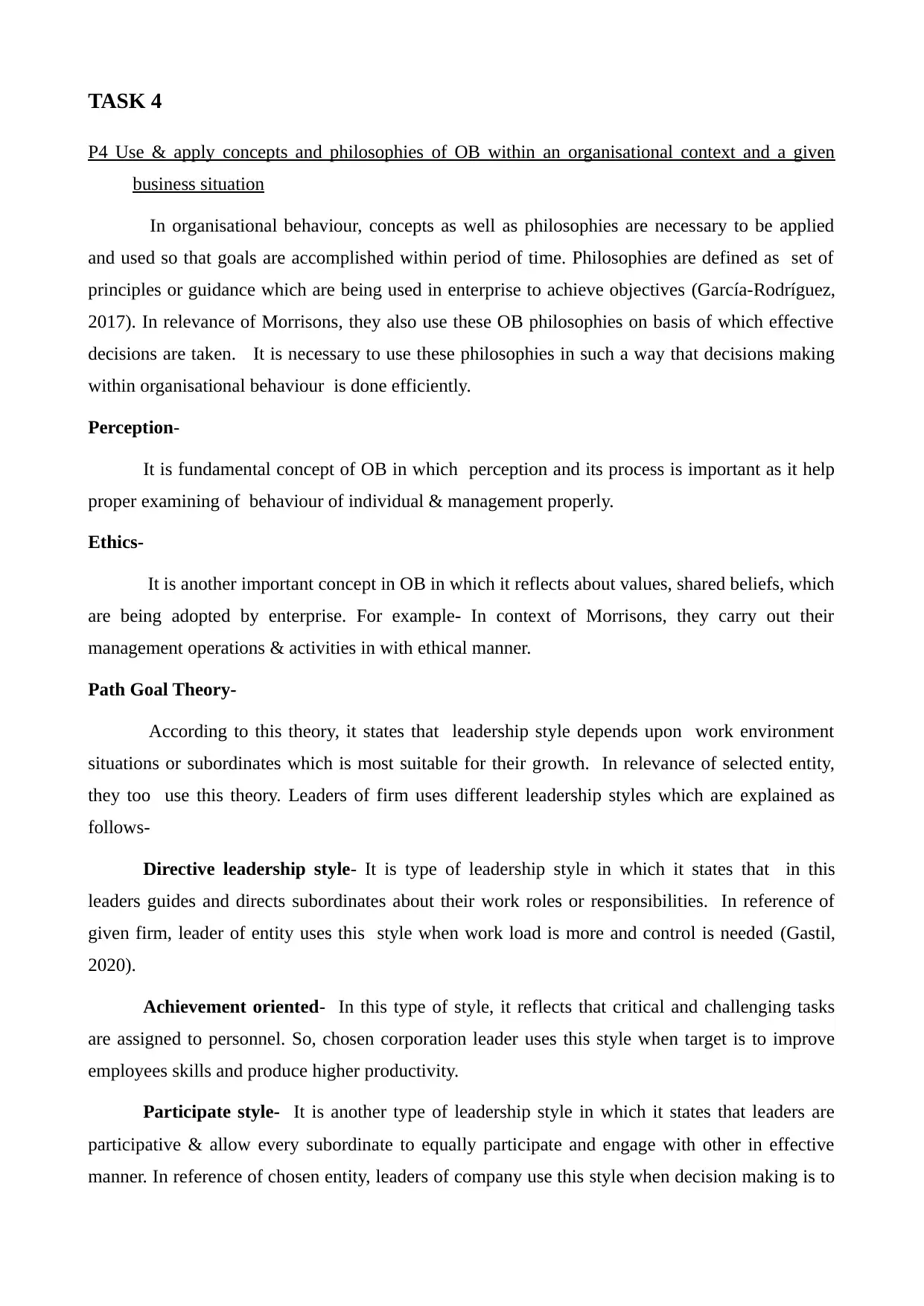
TASK 4
P4 Use & apply concepts and philosophies of OB within an organisational context and a given
business situation
In organisational behaviour, concepts as well as philosophies are necessary to be applied
and used so that goals are accomplished within period of time. Philosophies are defined as set of
principles or guidance which are being used in enterprise to achieve objectives (García-Rodríguez,
2017). In relevance of Morrisons, they also use these OB philosophies on basis of which effective
decisions are taken. It is necessary to use these philosophies in such a way that decisions making
within organisational behaviour is done efficiently.
Perception-
It is fundamental concept of OB in which perception and its process is important as it help
proper examining of behaviour of individual & management properly.
Ethics-
It is another important concept in OB in which it reflects about values, shared beliefs, which
are being adopted by enterprise. For example- In context of Morrisons, they carry out their
management operations & activities in with ethical manner.
Path Goal Theory-
According to this theory, it states that leadership style depends upon work environment
situations or subordinates which is most suitable for their growth. In relevance of selected entity,
they too use this theory. Leaders of firm uses different leadership styles which are explained as
follows-
Directive leadership style- It is type of leadership style in which it states that in this
leaders guides and directs subordinates about their work roles or responsibilities. In reference of
given firm, leader of entity uses this style when work load is more and control is needed (Gastil,
2020).
Achievement oriented- In this type of style, it reflects that critical and challenging tasks
are assigned to personnel. So, chosen corporation leader uses this style when target is to improve
employees skills and produce higher productivity.
Participate style- It is another type of leadership style in which it states that leaders are
participative & allow every subordinate to equally participate and engage with other in effective
manner. In reference of chosen entity, leaders of company use this style when decision making is to
P4 Use & apply concepts and philosophies of OB within an organisational context and a given
business situation
In organisational behaviour, concepts as well as philosophies are necessary to be applied
and used so that goals are accomplished within period of time. Philosophies are defined as set of
principles or guidance which are being used in enterprise to achieve objectives (García-Rodríguez,
2017). In relevance of Morrisons, they also use these OB philosophies on basis of which effective
decisions are taken. It is necessary to use these philosophies in such a way that decisions making
within organisational behaviour is done efficiently.
Perception-
It is fundamental concept of OB in which perception and its process is important as it help
proper examining of behaviour of individual & management properly.
Ethics-
It is another important concept in OB in which it reflects about values, shared beliefs, which
are being adopted by enterprise. For example- In context of Morrisons, they carry out their
management operations & activities in with ethical manner.
Path Goal Theory-
According to this theory, it states that leadership style depends upon work environment
situations or subordinates which is most suitable for their growth. In relevance of selected entity,
they too use this theory. Leaders of firm uses different leadership styles which are explained as
follows-
Directive leadership style- It is type of leadership style in which it states that in this
leaders guides and directs subordinates about their work roles or responsibilities. In reference of
given firm, leader of entity uses this style when work load is more and control is needed (Gastil,
2020).
Achievement oriented- In this type of style, it reflects that critical and challenging tasks
are assigned to personnel. So, chosen corporation leader uses this style when target is to improve
employees skills and produce higher productivity.
Participate style- It is another type of leadership style in which it states that leaders are
participative & allow every subordinate to equally participate and engage with other in effective
manner. In reference of chosen entity, leaders of company use this style when decision making is to
⊘ This is a preview!⊘
Do you want full access?
Subscribe today to unlock all pages.

Trusted by 1+ million students worldwide
1 out of 19
Related Documents
Your All-in-One AI-Powered Toolkit for Academic Success.
+13062052269
info@desklib.com
Available 24*7 on WhatsApp / Email
![[object Object]](/_next/static/media/star-bottom.7253800d.svg)
Unlock your academic potential
Copyright © 2020–2025 A2Z Services. All Rights Reserved. Developed and managed by ZUCOL.





